Technical Provisions
7.0 APPLICATION
The Forest Service Trail Accessibility Guidelines (FSTAG) provides guidance for maximizing accessibility of trails in the National Forest System, while protecting the unique characteristics of their natural setting. The FSTAG and the Forest Service Outdoor Recreation Accessibility Guidelines (FSORAG) are the legally enforceable standards for use in outdoor recreation areas on the National Forest System for the facilities, routes, and features addressed in these guidelines. Although not legally enforceable outside of the National Forest System, the Guidelines may be used by other entities to define best practices for trails.
These guidelines have been updated to incorporate the supplement to the Architectural Barriers Act Accessibility Standards, the Outdoor Developed Area Accessibility Guidelines (ODAAG), developed by the Architectural and Transportation Barriers Compliance Board (U.S. Access Board). While they incorporate the U.S. Access Board’s ODAAG they also ensure the application of equivalent or higher guidelines, in order to comply with other existing Forest Service policies, including universal design, as well as agency terminology and processes.
All trails in the National Forest System that (1) are new or altered; (2) have a Federal Trail Data Standard (FTDS) designation Designed Use of Hiker/Pedestrian; and (3) connect directly to a trailhead or to a trail that currently substantially complies with the FSTAG, shall comply with the FSTAG. Where provided, associated constructed features (such as tent pads, fire rings and pit toilets) located along National Forest System trails shall comply with the Forest Service Outdoor Recreation Accessibility Guidelines (FSORAG).
Side trails or other routes to associated constructed features off a trail are not outdoor recreation access routes. Therefore, they are subject only to section 7 of the FSTAG and do not have to comply with the technical provisions in section 2.0 of the FSORAG that apply to outdoor recreation access routes.
Trailheads and the constructed features at trailheads shall also comply with the applicable technical provisions of the FSORAG and ABAAS. Routes connecting those facilities are to comply with the FSORAG outdoor recreation access route specifications.
These guidelines do not apply to maintenance work (routine or periodic repair of existing trails, recreation sites, or facilities). Where existing individual site features are altered but the floor or ground surface under or around them is not altered, the clear floor or ground space shall not be required to comply with surface and slope requirements.
The FSTAG and FSORAG became the National Forest System’s legal standard for all applicable facilities on May 26, 2006 with the final Federal Register publication of Forest Service Manuals 2330 and 2350. As stated in the Federal Register, these guidelines would be updated periodically to ensure they remain equal to or a higher standard than other guidelines and standards applicable to Federal agencies under the Architectural Barriers Act.
Construction or alteration of all facilities within the National Forest System that are not addressed in the FSORAG or FSTAG shall comply with the applicable requirements of the Architectural Barriers Act Accessibility Standards (ABAAS). The FSTAG, FSORAG and ABAAS are all available at http://www.fs.fed.us/recreation/accessibility/.
Boating and fishing facilities, swimming pools, play areas, sports arenas, miniature golf courses, and amusement parks, which are referred to as “recreation facilities” are addressed in Chapter 10 of the ABAAS (http:// www.access-board.gov).
7.1 Conditions for an Exception
Where one or more of the following conditions exists on a trail, an “exception” provided in the guidelines for that specific technical requirement can be used where that condition exists. The exception shall not be used on the portion of the trail where the condition does not exist. If no exception is provided for the technical requirement, no exception is allowed. All other appropriate design options should be considered before applying the exception.
Condition for an Exception 1. Where compliance with the technical provision is not practicable due to terrain.
Condition for an Exception 2. Where compliance with the technical provision would fundamentally alter the function or purpose of the facility, trail, or the setting.
Condition for an Exception 3. Where compliance with the technical provision cannot be accomplished with the prevailing construction practices.
Condition for an Exception 4. Where compliance is precluded because the cultural, historic, or significant natural features are eligible for protection under Federal, State, or local law by:
-
Endangered Species Act (16 U.S.C. §§ 1531 et seq.);
-
National Environmental Policy Act (42 U.S.C. §§ 4321 et seq.);
-
National Historic Preservation Act (16 U.S.C. §§ 470 et seq.);
-
Wilderness Act (16 U.S.C. §§ 1131 et seq.); or
-
Other Federal, State, or local law the purpose of which is to preserve threatened or endangered species; the environment; or archaeological, cultural, historical, or other significant natural features.
7.2 General Exceptions
The basis for the determination that General Exception 1 or General Exception 2 apply shall be documented and maintained with the records of the construction or alteration project. Documentation shall include the rationale for that determination, which conditions for exception and which exceptions apply, the date of the determination, and the name of the individuals who made the determination. There is no standard format for this documentation; each unit may develop its own format to meet its specific needs.
7.2.1 General Exception 1.
Where a condition in 7.1 prohibits full compliance with a specific requirement in 7.4 on a trail segment, that trail segment shall comply with the specific requirement to the maximum extent practicable.
7.2.2 General Exception 2.
If after applying General Exception 1 it is determined that it is impracticable to provide a trail complying with 7.4, the trail shall not be required to comply with 7.4. Notification of this determination shall be sent to the Access Board. Website http://.access-board.gov/outdoor for optional use. For long-distance trails, this exception applies to the trail segments that are planned for construction or alteration in a given planning period, rather than over the entire length of the trail.
7.2.2.1 Determining Impracticability.
The use of General Exception 2 is reasonable where one or more conditions for an exemption in section 7.1 and at least one of the following limiting factors exist:
Limiting Factor 1. The combination of trail running slope (grade) and cross slope exceeds 1:2.5 (40 percent) for over a distance of 20 feet (6m).
Limiting Factor 2. The surface is not firm and stable for a distance of 45 feet or more (14 m).
Limiting Factor 3. The minimum trail width is 12 inches (305 millimeters) or less for a distance of at least 20 feet (6100 mm).
Limiting Factor 4. A trail obstacle of at least 30 inches (770 mm) in height extends across the full width of the trail.
Limiting Factor 5. One or more conditions for an exception exist that result in significant deviations from the technical provisions of section 7.4.1 through 7.4.8 for over 15 percent of the length of the trail.
7.2.2.2 Extent of Impracticability.
Where General Exception 2 permits exemption of an entire trail from the requirements of section 7.4.1 through 7.4.8, it may be beneficial to construct a portion of the trail to meet the trail accessibility guidelines. Consider doing so especially if a prominent feature (such as a scenic view, waterfall, or other feature that would be of interest to visitors) is located between the trail terminus and the first extreme environmental barrier and there are few or no significant conditions requiring exceptions on that portion of the trail.
7.3 Definitions
All trail-related definitions used in the FSTAG are from the Forest Service Manual or Handbook, the Forest Service Infra Trails Module, Trail Assessment and Condition Survey (TRACS) reference materials, or are mandated by the Access Board.
“Accessible Trail” is a term to avoid.
The technical provisions in section 7.4 of the FSTAG allow for grades up to 12 percent. While such grades are understandable in challenging terrain as hiking paths selected by choice, the general public’s expectation of an “accessible” pathway is that it have a gentle grade and other uniform factors. In addition, most trails constructed under the FSTAG use exceptions to some extent in order to maintain the nature of the setting.
Therefore, a trail that has been constructed in accordance with the FSTAG should be advertised as a “trail that complies with the trail accessibility guidelines”, rather than as an “accessible trail”. Information concerning grades, etc. is to be posted along with other trail information on websites, trailhead signs, and so forth. Each visitor can then select the trail that best meets their recreation experience and expectations.
Alteration.
A change in the original purpose, intent, or function of a trail.
Camp Shelter.
A partially enclosed structure that provides campers and hikers cover from weather and that does not contain plumbing fixtures or kitchen appliances. Camp shelters are not cabins, which are typically larger and are required to comply with ABAAS section 806 for transient lodging where short term accommodations are provided.
-
Associated Constructed Feature. A constructed element associated with a trail that provides support for trail users, but is not a part of the trail tread. Examples include overnight shelters, toilets, fire rings, picnic tables, and tent pads. Refer to the FSORAG for the technical provisions for associated constructed features.
-
Trail Constructed Feature. A constructed feature that functions as part of the trail tread. Examples include puncheon, trail bridges, boardwalks, waterbars, and switchbacks. For a listing of trail constructed features, refer to the trail documentation available at http://www.fs.fed.us/recreation/programs/trail-management/index.shtml or available to Forest Service employees at http://fsweb.wo.fs.fed.us/rhwr/ibsc/tr-cost.shtml
Designed Use.
The “Managed Use” of a trail that requires the most demanding design, construction, and maintenance parameters. In conjunction with the applicable “Trail Class,” designed use determines which design parameters will apply to a trail. It is an FTDS term for the intended use that controls the geometric design of a trail and determines the level to which it should be maintained. There is only one “Designed Use” per trail or trail segment.
Federal Trail Data Standards (FTDS).
Standardized terminology that enable national, regional, and State trail managers, and the public, to use mutually understood terminology for recording, retrieving, and applying spatial and tabular information. FTDS make it easier for trail information to be accessed, exchanged, and used by more than one individual, agency, or group. The data standards are available at http://www.nps.gov/gis/trails/Doc2/Federal_Trail_Data_Standards_Final_20111108.pdf
Hiker/Pedestrian Trail.
A trail with a designed use of hiker/pedestrian that is designed, constructed, and maintained for hiker/pedestrian use.
Limiting Factor.
An extreme, uncorrectable environmental barrier that makes the trail beyond the barrier unreachable for many people with mobility limitations.
Maintenance.
Routine or periodic repair of trails or trail segments to restore them to the standards to which they were originally designed and built. Maintenance does not change the original purpose, intent, or design of a trail.
Managed Use.
An FTDS term for the mode(s) of travel for which a trail is actively managed. Managed uses are the specific types of trail use that are allowed by management decision or intent on a specific trail or portion of a trail. Each trail or trail segment may have more than one “Managed Use.” For example, a trail may be managed for both equestrian and hiker/pedestrian use in the summer and for cross-country skiing in the winter.
Outdoor Recreation Access Route (ORAR).
A continuous, unobstructed path for pedestrian use that connects elements in an outdoor recreation area such as a picnic area, campground, or trailhead.
Pit Toilet.
A primitive outhouse consisting of a toilet riser over a hole dug into the ground or receptacle to receive and naturally decompose human waste. Pit toilets are provided primarily for resource protection and are only constructed at recreation sites with a Recreation Site Development Scale level of 2 of less. A pit toilet riser may or may not be surrounded by walls and may or may not have a roof. A pit toilet may be permanently installed or may be moved from one location to another as the pit is filled or the area becomes severely impacted from use. Waste may be disposed of directly into the pit or may be composted.
Practicable.
Practicable in this context means the work can be completed within the limits of the applicable Conditions for an Exception and results in a useful improvement for all.
Prominent Feature.
A natural, cultural, or historic feature located along or adjacent to a trail that is determined by a trail designer or manager to have national, regional, or local distinction or significance. A prominent feature may be the focal point, main attraction, or destination of a trail, or it may simply be an interesting secondary feature. Examples include but are not limited to boulder outcrops, waterfalls, groupings of old or unique trees or other vegetation, vistas that may or may not be part of a developed overlook, and cultural or historic structures.
Protruding Object.
A constructed feature such as a sign that extends into the trail tread more than 4 inches (100 mm) between 27 inches (685 mm) and 80 inches (2030 mm) above the trail tread. Accessibility guidelines for protruding objects do not apply to naturally occurring objects, such as tree branches, or rock ledges. However, safety regulations or Forest Service construction and maintenance standards may define clear space and limit overhangs of natural protruding objects.
Provisions.
The sections of accessibility guidelines and standards that explain what is required for specific situations and facilities (parking, picnic tables, trails, etc.)
Recreation Site.
An area that is improved, developed, or otherwise identified for recreation and that has a development scale of 0, 1, 2, 3, 4, or 5 (See Forest Service Handbook 2309.13, Chapter 10 – Exhibit 01).
Reconstruction.
This term is not used in Federal accessibility guidelines or the FSTAG and FSORAG, even though it is used frequently by personnel who work in recreation and trails. For the purposes of the FSTAG and FSORAG, actions are categorized as construction, alteration, or maintenance.
Scoping Requirement.
Specifications of where, when, and how much of a constructed features detailed in the accessibility guidelines technical requirements must be met in order to comply with the FSTAG.
Slope.
The incline of a surface.
-
Cross Slope. The percentage of rise to length, which is the difference in elevation, when measuring the trail tread from edge to edge perpendicular to the direction of travel This may be expressed as the percentage of change in elevation or as a ratio of vertical distance to horizontal distance. The percentage is shown in parentheses in these guidelines.
-
Running Slope (Grade). The ascent or descent of a trail segment expressed as a percentage of its length, which is the difference in elevation of a section of a trail measured parallel to the predominant direction of travel. This may be expressed as a ratio of vertical distance to horizontal distance or as the percentage of change in elevation. The percentage is shown in parentheses in these guidelines.
Surface.
The top layer of a trail.
-
Firm. A firm surface resists deformation by indentations. During the planning process, firmness must be evaluated for noticeable distortion or compression during the seasons for which the surface is managed, under normally occurring weather conditions.
-
Stable. A surface is not permanently affected by expected weather conditions and can sustain normal wear and tear from the expected use(s) of the area, between planned maintenance.
Technical Requirements.
Are the specific numbers, conditions, and measurements that are required to be achieved (percent that must comply, dimensions, reach ranges, grades, trail width, etc.).
Trail.
For purposes of the FSTAG and FSORAG, a trail is a pedestrian route developed primarily for outdoor recreational hiking purposes. A pedestrian route provided primarily to connect elements, spaces, or facilities within a site is not a trail; it is an outdoor recreation access route (ORAR).
Trail Class.
The prescribed scale of development for a trail, representing its intended design and management standards.
Trail Grade.
The ascent or descent of a trail segment expressed as a percentage of its length. When expressed as a ratio of rise to length to the term used is running slope.
Trailhead.
For the purpose of the FSTAG a trailhead is an outdoor space that is designated by the entity responsible for administering or maintaining the trail to serve as a primary access point to the trail. The simple junction of two or more trails, or the undeveloped junction of a trail and a road, is not a trailhead.
Trail Segment.
The portion of a trail being planned, evaluated, or constructed.
Trail Tread.
The portion of a trail upon which traffic moves.
Trail Terminus.
For the purpose of the FSTAG the trail terminus is the beginning or ending point of a trail or trail segment, where a trail assessment or trail work begins or ends.
Tread Width.
The visible trail surface measured perpendicular to the direction of travel.
-
Clear Tread Width. The width of the usable trail tread and adjacent usable surface.
-
Minimum Tread Width. The width of the usable part of the tread width at the narrowest point on a trail.
-
Minimum Trail Width. The width of the trail tread and the adjacent usable surface at the narrowest point on a trail.
Wheelchair.
A device, including one that is a battery-powered, that is designed solely for use by a mobility-impaired person for locomotion and that is suitable for use in an indoor pedestrian area. A person whose disability requires use of a wheelchair or mobility device may use a wheelchair or mobility device that meets both parts of this definition anywhere foot travel is permitted (per 36 CFR 212, FSM 2350, and in Federally designated wilderness under ADA Title V, section 508c).
7.4 Technical Provisions
General: Trails shall comply with 7.4.
7.4.1 Surface.
The trail tread surface, including resting intervals and passing spaces, shall be both firm and stable.
7.4.2 Clear Tread Width.
The clear tread width of the trail shall be at least 36 inches (915 mm).
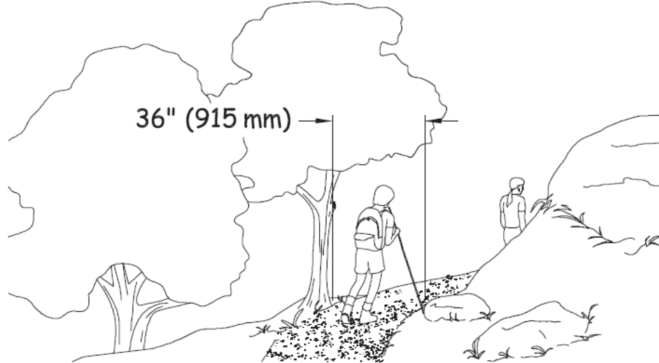
EXCEPTION: Where a condition for an exception prevents achieving the required width, the clear tread width may be reduced to 32 inches (815 mm) minimum. If the condition for an exception prevents achieving the reduced width of 32 inches, comply to the extent practicable.
7.4.3 Slope.
Trail running slopes (grades) and cross slopes shall comply with sections 7.4.3.1 and 7.4.3.2.
7.4.3.1 Running Slope (Grade).
The running slope (grade) of trail segments shall comply with this section and shall be consistent over the distances cited.
-
Trail running slope (grade) of up to 1:20 (5 percent) is permitted for any distance.
-
The running slope of any segment of a trail shall not be steeper than 1:8 (12 percent).
-
No more than 30 percent of the total trail length may exceed a running slope (grade) of 1:12 (8.33 percent).
-
Where the running slope (grade) of a segment of a trail is steeper than 1:20 (5 percent), the maximum length of the segment shall be in accordance with Table 7.4.3.1, and a resting interval complying with 7.4.4 shall be provided at each end of the segment.
Table 7.4.3.1 Trail Running Slope (Grade) and Resting Intervals
|
Running Slope of Trail Segment |
Maximum Length of Segment Between Resting Intervals |
|
| Steeper Than | But Not Steeper Than | |
|
1:20 (5 percent) |
1:12 (8.33 percent) |
200 feet (61 m) |
|
1:12 (8.33 percent) |
1:10 (10 percent) |
30 feet (9 m) |
|
1:10 (10 percent) |
1:8 (12 percent) |
10 feet (3050 mm) |
7.4.3.2 Cross Slope.
The cross slope shall not exceed 1:20 (5 percent). Where the surface is paved or is elevated above the natural ground, the cross slope shall not be steeper than 1:48 (2 percent).
7.4.4 Resting Intervals.
Resting intervals shall comply with 7.4.4. Where the trail grade exceeds 1:20 (5 percent), resting intervals shall be provided as specified in Table 7.4.3.1.
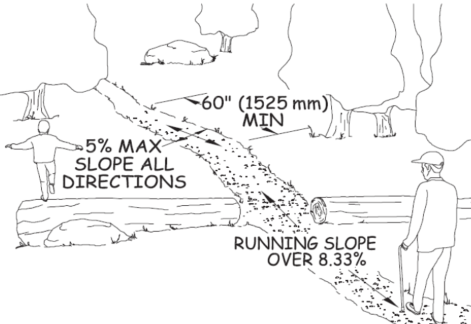
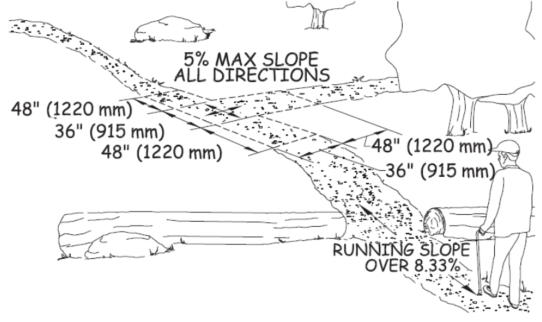
7.4.4.1 Length.
The resting interval length shall be 60 inches (1525 mm) long minimum.
7.4.4.2 Width.
Where resting intervals are provided within the trail tread, resting intervals shall be at least as wide as the widest segment of the trail tread leading to the resting interval. Where resting intervals are provided adjacent to the trail tread, the resting interval clear width shall be 36 inches (915 mm) minimum.
7.4.4.3 Slope.
The slope of a resting interval shall not exceed 1:20 (5 percent) in any direction. Where the surface is paved or is elevated above the natural ground, the slope shall not be steeper than 1:48 (2 percent) in any direction.
7.4.4.4 Turning Space.
Where resting intervals are provided adjacent to the trail tread, a turning space complying with ABAAS section 304.3.2 shall be provided. Vertical alignment between the trail tread, turning space, and resting interval shall be nominally level. The trail tread, turning space, and resting interval may overlap.
7.4.5 Passing Spaces.
Trails with a clear tread width less than 60 inches (1525 mm) shall provide passing spaces complying with 7.4.5 at intervals of 1000 feet (300 m) maximum. A passing space must also be provided at the end of any segment of trail that meets the requirements of 7.4, if the full length of the trail does not meet the requirements. Passing spaces and resting intervals may coincide or overlap.
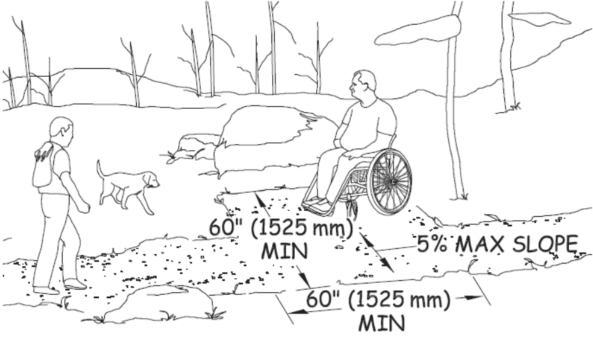
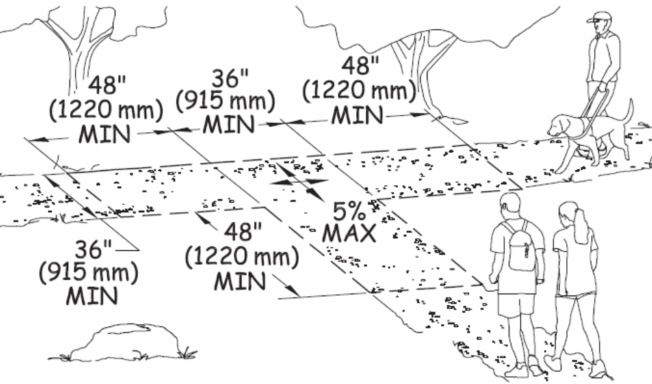
7.4.5.1 Size.
The passing space shall be either:
-
A space 60 inches (1525 mm) minimum by 60 inches (1525 mm) minimum; or
-
The intersection of two trails providing a T-shaped space complying with ABAAS section 304.3.2 where the base and the arms of the T-shaped space extend 48 inches (1220 mm) minimum beyond the intersection. Vertical alignment at the intersection of the trails that form the T-shaped space shall be nominally level.
7.4.5.2 Slope.
The cross slope of a passing space shall not exceed 1:20 (5 percent) in any direction.
7.4.5.3 Non-complying Segment Ends.
Where a segment of the trail does not comply with 7.4, a passing space shall be located at the end of each adjacent trail segment that does comply with 7.4.
7.4.6 Tread Obstacles.
Tread obstacles on trails shall not exceed 2 inches (50 mm) in height measured vertically to the highest point. Where the trail surface is paved or is elevated above the natural ground, tread obstacles shall not exceed ½ inch (13 mm) in height measured vertically to the highest point.
7.4.7 Openings.
Openings in trail tread surfaces, trail resting spaces, and trail passing spaces shall be small enough to prevent passage of a 1/2 inch- (13 mm-) diameter sphere. Where possible, elongated openings should be placed perpendicular, or as close to perpendicular as possible, to the dominant direction of travel.
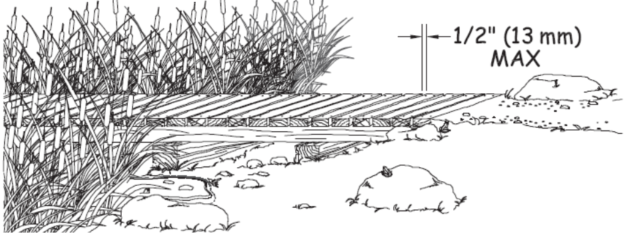
Exception: Where openings that do not permit the passage of a ½ inch (6.4 mm) sphere cannot be provided due to a condition for an exception, openings that do not permit passage of a ¾ inch (19 mm) sphere shall be permitted.
7.4.8 Protruding Objects.
Constructed features, including signs, shall not extend into the trail tread more than 4 inches (100 mm) between 27 inches (685 mm) and 80 inches (2030 mm) above the surface of the trail.
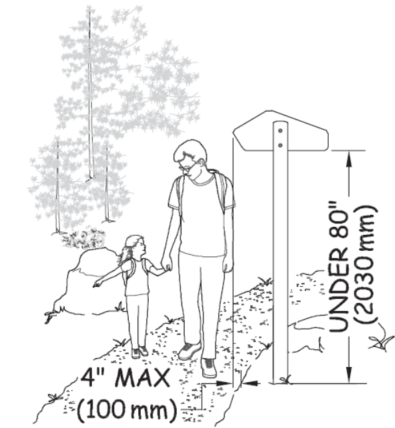
7.4.9 Trail Facilities.
Where provided on trails, facilities shall comply with the applicable provisions of the FSORAG. ORARs are not required at or between facilities on trails.
Exception. When the surface of the required clear ground space for trail facilities is not paved or is not elevated above the natural ground, slopes not steeper than 1:20 (5 percent) shall be permitted where necessary for drainage.
7.4.10 Trailheads.
Trailheads shall comply with 7.4.10.
7.4.10.1 Outdoor Constructed Features.
Where provided within trailheads each outdoor constructed features such as parking spaces, toilets, or camp sites shall comply with the applicable portions of the FSORAG and ABAAS.
7.4.10.2 Outdoor Recreation Access Routes (ORARs).
At least one outdoor recreation access route complying with FSORAG section 2.0 shall connect the following places at trailheads:
-
Accessible parking spaces or other arrival point;
-
Starting point of the trail; and
-
Accessible outdoor constructed features, elements, spaces, and facilities within the trailhead.
Exception 1. In alterations to existing trailheads, where a condition for exception prohibits compliance with a technical provision, the ORAR shall comply with FSORAG 2.0 to maximum extent practicable.
Exception 2. Where elements, spaces, or outdoor constructed features are altered at trailheads but the circulation path is not altered, an outdoor recreation access route shall not be required.
7.4.11 Trailhead Signs.
Where new trailhead information signs are provided at trailheads on newly constructed or altered trails, they shall comply with 7.4.11.
7.4.11.1 Clear Space.
Trailhead signs shall be located centered at the back of a 30- by 48-inch (760- by 1,220-millimeter) minimum clear floor or ground space. The clear space shall not overlap the trail width but may overlap a resting space or passing space. The slope of the clear space shall not exceed 1:20 (5 percent) in any direction.
7.4.11.2 Sign Contents.
Where new trail information signs are provided at trailheads on newly constructed or altered trails, regardless of whether the trail is accessible, the signs shall include at minimum the following information:
-
Length of the trail or trail segment
-
Surface type
-
Typical and minimum tread width
-
Typical and maximum running slope
-
Typical and maximum cross slope
-
A statement that the posted information reflects the condition of the trail when it was constructed or assessed, including the date of the construction or assessment
Where more extensive trail information is provided (e.g., an aerial map of the trail and related facilities), the location of specific trail features and obstacles that do not comply with the technical provisions in 7.4 should be identified and a profile of the trail grade should be included.
7.4.11.3 Reach Ranges.
If materials need to be obtained from or manipulated on a sign or kiosk, the sign or kiosk shall be designed to meet the reach ranges in section 308 of the ABAAS.
7.4.12 Gates and Barriers.
Where gates or barriers are constructed to control access to trails, gates and barriers shall comply with 7.4.12.
7.4.12.1 Clear Width.
Gate openings and openings in barriers for hiker passage shall provide a clear width of 36 inches (915 mm), complying with ODAAG, section 1017.3 Clear Tread Width.
7.4.12.2 Gate Hardware.
Gate hardware shall comply with operable controls requirements in ABAAS section 309.4 and 404.2.7.

User Comments/Questions
Add Comment/Question